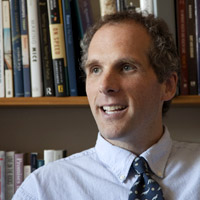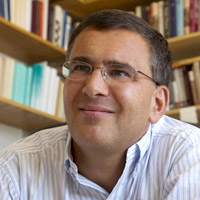The U.S. health care system has been ranked 2nd in the world in expenditures—and 38th in the world in performance. What's going on?
In sickness and in health, the United States is a nation of extremes, paying more for health care—and getting less health in return—than almost any other country in the world.
Faculty in MIT’s School of Humanities, Arts, and Social Sciences have spent years investigating the economic, political, and social implications of our current system—and ways to improve it.
As Congress moves towards enacting historic health system reform, four School experts—David Jones, M.D., Andrea Campbell, Erica James, and Jonathan Gruber—provide deep perspective on why America has the system it has and what will, and will not, work to provide a system that is healthier—both for "We, the People," and for the national pocketbook.
Priorities
"This is an extraordinarily wealthy country," says David Jones, a physician and Associate Professor in the Program in Science, Technology, and Society.
"The ability of the country to generate hundreds of billions of dollars for a war in Iraq over the past 10 years and to generate hundred of billions of dollars for bailouts—dollars people didn’t realize were available—suggests that if we wanted to fully fund a health care system, we do have the resources. Our current system reflects our national priorities," he says. “When there is political will or perceived necessity, resources are made available."
And yet, as a country, we’re already spending a fortune on health care.
“If health care spending continues on its current trajectory, by 2050 health care will be 50 percent of our economy,” says Andrea Campbell, Associate Professor of Political Science. She points out that spending is currently growing 2.5 percent faster than growth in gross domestic product, a pace that is unsustainable.
Why Such Poor Results?
So why aren’t we getting better results? The World Health Organization rated the U.S. health system second in the world in expenditures, but 38th in the world for performance in 2000. According to the Centers for Disease Control and Prevention (CDC), the infant mortality rate is higher in the United States than in 29 other countries, including the Czech Republic, Cuba, and Israel.

Ironically, American’s collective unwillingness to pay
for universal health care costs the country dearly.
Without good preventive care, America’s 43.6 million
uninsured must often resort to emergency and acute care—
the most expensive types of medical treatment.
Health Care for Some
One major reason for the poor performance is the disparity in health care among different segments of the population. Infant mortality rates in the U.S. range broadly when separated by race and ethnicity—from a high of 13.63 death per 1,000 live births for non-Hispanic black women, to a low of 4.42 for Cuban women, according to 2005 figures reported by the National Center for Health Statistics. The rate of infant mortality among African Americans is thus more than twice the national average of 6.68 deaths per 1,000 live births. Rates for Puerto Ricans, American Indians, and Alaska Natives are also high.
Disparities in care are also evident elsewhere in the system. For example, in 2008 the CDC found that 43.6 million people lack health insurance in the United States. The Institute of Medicine of the National Academies estimates that lack of health insurance causes roughly 18,000 unnecessary deaths each year in the United States. Yet ours remains the only industrialized nation in the world that fails to guarantee health care access to its citizens. Why?
The Power Factor
“One reason health care reform has failed in the past is that the principal goal was to provide health care to the uninsured, but the uninsured themselves are not politically powerful,” Campbell observes.
Associate Professor of Anthropology Erica James’ research touches on the effects of this powerlessness on the people involved. She explores the challenges faced by a Boston-area faith-based charity in serving the needs of Haitian immigrants and refugees—a population that faces a variety of barriers to health care, including political insecurity (many are undocumented), economic difficulties, and the challenges presented by the complexity of America’s health care infrastructure.
“When you’re not in the system, what do you do?” James asks. The short answer would appear to be: suffer. James, who has written about the deeply damaging effects of living in the dangerous and dysfunctional country that Haiti has become, has found similar health repercussions among undocumented Haitian immigrants in Boston.
What are the health repercussions of limited power?
Erica James, Associate Professor of Anthropology, explores
the challenges of serving the health needs of Haitian
immigrants and refugees—a population that faces a variety
of barriers to good care.
Time for Real Reform?
“[U.S.] policies, and the practices that they instill, can have the unintended consequences of exacerbating the trauma and ontological vulnerability that many poor Haitians experience both in Haiti and abroad,” James writes.
Complex social issues—exemplified by those facing Boston’s Haitian community—are a big, unspoken element in the health care crisis nationwide, the School’s professors say. The question on everyone’s mind, according to Campbell, is whether the present recession has changed the balance of power sufficiently to present a political opportunity for real health care reform.
“Are conditions severe enough, and have enough middle class people lost their insurance, that there’s enough momentum to change the underlying system?” Campbell asks. “It’s an open question.”
The Will to Change
Universal coverage in America is expected to cost $1 trillion over 10 years—not a small amount, but a figure equivalent to the amount health care costs rise each year, according to Jonathan Gruber, Professor of Economics. “Think about it, we could cover all the uninsured in America for the cost of one year’s growth in cost,” he says.
Gruber, who is one of the architects of Massachusetts’ universal health care plan, believes that coverage is fundamental to health reform. The Commonwealth’s system, which has been held up as a model for the nation, is a hybrid that marries mandated individual and employer-sponsored coverage with a public health insurance option.
Luxury or Humanity?
“I think the key policy issues are, first of all, do we mandate that everyone has health insurance? And that has basically been decided ‘Yes,’” Gruber says. “Another big issue, if you’re going to mandate, you have to subsidize—which means you have to pay for it. So where’s the money going to come from?”
“Where’s the money coming from” is the crucial sticking point, and not only because the numbers involved are large. Again, it comes down to political will, and in the U.S., health care is seen as a luxury, Jones says.
“There’s a lot of victim blaming in health care,” he observes, citing HIV, emphysema, and depression as three examples of diseases commonly blamed on patients. “The people of this country still aren’t willing to commit to providing health care for everyone, and that is a real political tragedy.”
“I think it would outperform private insurance,”
Jones says, of a U.S. public option for health insurance.
David Jones, M.D.
Associate Professor,
Program in Science, Technology, and Society
Blaming Victims
James has seen the effects of victim blaming in her research on Haitian immigrants. Stigmatized by the public perception of Haitians as vectors for HIV transmission, and often living “in the shadows” as undocumented aliens, Haitians suffer the health repercussions typical of populations whose access to health services is limited. They are, for example, less likely to be screened for such common diseases as diabetes, hypertension, and prostate cancer, with predictable results.
“It’s not a pretty picture,” says Jones, who found a lot of victim blaming (e.g.: they eat badly, have bad genes, bad hygiene) in his research into health care gaps between whites and Native Americans in the United States. America’s strong streak of individualism also contributes to the American slowness to provide universal health care—there’s a sense that people in need brought the problems on themselves.
“The explanations people give for health disparities tend to support the agenda of the people in power,” Jones observes, noting that when reservations were first set up for various Native American tribes in the 1800s, the people in power believed it didn’t matter that the land was too poor to support them. The “Indians,” in their view, had weak constitutions and were destined to die off anyway.
The Power of the Status Quo
So, who holds the reins of power in American health care today?
“The most important groups are the providers (hospitals and doctors) and the insurance companies because they have this very tangible and large stake in any reform that comes down the pike,” says Campbell, adding that another key group is the people who have insurance. “They can be a powerful blocking force if they feel a proposed reform is going to diminish their own current health insurance situation,” she says.
Ironically, Americans’ collective unwillingness to pay for health care for certain populations—immigrants, the unemployed, and the underprivileged—is costing us money. America’s 43.6 million uninsured are more likely to skip low-cost preventative treatments and early intervention, and instead resort to the most expensive types of care—emergency and acute care.
“When I worked in emergency rooms, it was clear that they were bad settings for providing routine care. It would be much cheaper to provide primary care rather than waiting until people present to emergency rooms,” Jones says. “I think that if we provided care to everyone, costs would come down.”
Insuring Everyone Would Be Less Expensive
As it stands, Americans are footing at least part of the bill for the same people they have been unwilling to insure, because uncompensated care often comes out of public funds—to the tune of $57 billion in 2008, according to the Kaiser Commission on Medicaid and the Uninsured.
“People without health insurance tend to live sicker and die younger than people with health insurance,” according to the American College of Physicians-American Society of Internal Medicine, so it’s reasonable to argue that insuring everyone would be less expensive than our current system because we would reap the benefits of a healthier population.
Nevertheless, Americans who do have health insurance are naturally concerned that changes might leave them with fewer or poorer health care options. Critics of national health insurance reform often cite horror stories from countries with government-run health care systems: long waits for treatment, denied procedures, inaccessible brand-name drugs.
“I think that’s the way arguments go; people argue at the extremes,” Gruber says. “We have a lot of cost control we can do before we have to start to ration care.”
“No one likes rationing,” Jones says. “But we’re rationing now. We’re rationing by socioeconomic status.”
"The current system of employer-sponsored health
insurance effectively locks people into their jobs,
strangling U.S. entrepreneurship."
Jonathan Gruber
Professor of Economics,
MacVicar Faculty Fellow, Department of Economics
The Devil in the Details
Although some will claim that the U.S. has a free market insurance system, that’s not really true. Very large segments of the population—including veterans, seniors, and public servants (including, famously, U.S. senators and congressional representatives)—are already enrolled in public health plans. In addition, explicit government policies shape and support the status quo insurance system—warts and all.
“[Government] program design profoundly shapes the nature of democratic citizenship,” says Campbell, whose research centers on the interplay between policy and political behavior. (She is currently writing a book titled The Delegated Welfare State: Medicare, Markets, and the Future of American Governance.) As an example, Campbell cites the political effects engendered by Social Security and welfare. While the Social Security program has greatly empowered the elderly, who are now a formidable political force, the poor have not been similarly empowered by welfare.
Designing Fairness
The difference is due to design, Campbell says. While Social Security is provided to everyone, welfare participation requires proof of poverty, which can be a demeaning experience that undermines political efficacy. “Participants in non-means-tested programs participate more in government,” she notes.
In the health care arena, one policy that shapes any discussion of reform is the “tax exclusion.” Currently, the government taxes wages, but excludes the compensation that comes in the form of employer-sponsored health insurance. “It’s really a big issue,” Gruber says. “It’s unfair because the richer you are the bigger break you get. And it’s discriminatory, because if you’re employed you get it, otherwise you don’t.”
Ending the tax exclusion has the potential to provide $150 billion a year in income tax revenue, which would go a long way to paying for universal health care. But that’s politically unpopular.
"Caps"
“The tax exclusion is an extraordinarily tricky issue both economically and politically,” Campbell says. “It encourages people to buy really expensive insurance. In that sense we are subsidizing the most affluent. On the other hand, you need the affluent on board with any kind of reform. So I think a reasonable compromise would be to cap it.”
Gruber, who also favors a cap, offered this example of the tax exclusion at work: Imagine a company wants to give an employee $10,000. If the employee receives the money as wages, he gets $6,000 and the government gets $4,000. However, if the company provides $10,000 in health insurance, the employee benefits from the full $10,000, and the government gets nothing.
“[The tax exclusion] is the second largest federal expenditure on health care after Medicare,” Gruber points out. In fact, one theory as to why real wages have been flat since the early 1990s is that any increases in compensation have been going to pay for increases in the cost of health insurance, Campbell says. If employers took that money and gave it to their employees in cash, workers would arguably have the incentive to shop around for the most cost-effective plan, because they could keep the difference.
"Beyond sorting out policy, improving actual health
goes much deeper than dollars and cents. The good news,
as the CDC reports, is that many diseases are preventable.
Universal Health Insurance is Good for Entrepreneurs
The current system of employer-sponsored health insurance also effectively locks people into their jobs, strangling entrepreneurship, Gruber observes. “Workers are often unwilling to leave a current job that provides health insurance for another position that might not, even if they would be more productive in that other position,” he writes in Washington Monthly. “This is because employer-provided insurance is traditionally the only reliable form of fairly priced private insurance coverage available in the U.S.”
The tax exclusion exacerbates this problem—and actively contributes to rising medical costs—because it effectively makes insurance cheaper for employees to buy. The result is that people buy more, whether they need it or not, Gruber says. Faith in the free market for insurance is further undercut by consolidation within the industry, which has led to a clear failure of competition in many insurance markets around the nation. According to the American Medical Association, single health insurers dominate the market in the majority of metropolitan areas. “But, whether a public insurance option would make this problem better or worse is unclear,” Gruber says. “On the one hand, it would provide an extra degree of competition. On the other hand, formal or informal government subsidies of this option could tip the playing field and lead to even less competition in the end.”
A Nation of Consumers
Another likely culprit in the high cost of U.S. health care is excessive consumption. Whether that’s because doctors are ordering unnecessary tests to protect themselves from liability, or because consumers are demanding brand-name drugs or other trendy treatments, it’s clear there are unexplained disparities in consumption within the United States.
In June 2009, The New Yorker magazine spotlighted the shocking range of health care costs across the country by profiling two Texas counties with similar demographics. One paid Medicare $7,504 per enrollee; the other paid $15,000—without significantly better health outcomes. The article quotes Peter Orszag, President Obama’s budget director, who says, “Nearly 30 percent of Medicare’s costs could be saved without negatively affecting health outcomes if spending in high- and medium-cost areas could be reduced to the level in low-cost areas."
Citing the New Yorker article, Jones says that if counties paying the most are getting the same results as those paying less, then “that suggests there’s overuse.” Unfortunately, it’s extraordinarily difficult to determine why there is overuse. In his current research, Jones is zeroing in on one piece of the puzzle, examining how trends in cardiac care have contributed to high rates of health care utilization. For example, some procedures, such as angioplasty, remain popular even though they don’t show the bottom-line results of preventing heart attacks in most patients.
Such research is the key to long-term improvements in our nation’s health care system, and it is a continuing process within MIT’s School of Humanities, Arts, and Social Sciences. Economists, for example, still need to do more basic research on how to address costs, Gruber says. “We’re maybe 5-10 years away from telling policy makers what to do on this.” However, he didn’t consider that a reason to delay health care reform. “What I’d like to see first is getting universal coverage. Cost control we don’t quite know how to do yet. Coverage we do,” he says, citing the Massachusetts example.
“Are conditions severe enough—
and have enough middle class people lost
their insurance—that there’s momentum
to change the system?”
Andrea Campbell
Hayes Career Development Associate Professor,
Department of Political Science
Success Stories
The Massachusetts system that Gruber helped devise takes an incremental approach to universal coverage. Gruber has served on the board of the Massachusetts Insurance Connector, the main implementing body for the state’s ambitious health care reform effort, since its founding in 2006. The state provides subsidized and free health care for people at certain income levels, creating a large risk pool. And it mandates that everyone have health insurance, or face a tax penalty.
Since the Massachusetts plan went into effect, the rate of uninsured in the state has dropped to 2.7 percent, with 150,000 people joining employer-sponsored health plans. And the system enjoys 75 percent public approval.
But the cost question lingers, and it’s an especially apt question in light of the current recession. “Fundamental cost control is about telling people they can’t have what they want”—and that is not likely to happen in the U.S. anytime soon, Gruber says.
So, is it simply impossible to run an effective national health care system on a budget? Interestingly, the federal government is already running one efficient health care program—with a capitated budget, Campbell says. The Veterans Health Administration is the highest rated health care provider in America—providing health care to 5.5 million Americans, despite having to live within its limited means.
“The VA has had an incredible turnaround in the last 10 years,” Campbell says, instituting electronic medical record-keeping and other innovations to make the most of the funding available. “It’s an example of innovation occurring because of constrained resources.”
The key is clearly to find efficiencies, and some private companies (including the nonprofit Mayo Clinic) have also been successful in holding down costs without sacrificing care. “If you’re able to purge unnecessary treatments, that’s not really rationing,” Jones says.
By comparison, private insurers waste a lot of health care dollars trying not to insure people, Campbell says. “One of the reasons that we pay so much more for health care in the U.S. is that the administrative costs associated with private insurance are far, far higher than those associated with a government payer,” she says.
The Public Option: A Consensus
In the end, Campbell, Gruber, and Jones all say they would like to see a public option included in any national health care reform legislation. “I think it would outperform private insurance,” Jones says.
Be that as it may, it’s clear the United States is not going to nationalize a $500 billion industry, Gruber says. “If you think about steps toward cost control in America, there are easy steps and there are harder steps,” he says. Starting with universal coverage will give everyone a stake in controlling costs going forward, he says.
In a speech to Congress in February, President Obama said, “I suffer no illusions that this will be an easy process. It will be hard. But I also know that nearly a century after Teddy Roosevelt first called for reform, the cost of our health care has weighed down our economy and the conscience of our nation long enough.”
On this, those in the School who have dedicated their careers to studying our current health care system agree. ∎

Related article:
Sources of Health
Prepared by MIT SHASS Communications
Editor and Design Director: Emily Hiestand
Writer: Kathryn O'Neill
Photography: Photographs of Professors Campbell, Gruber, James, and Jones by Jonathan Sachs





